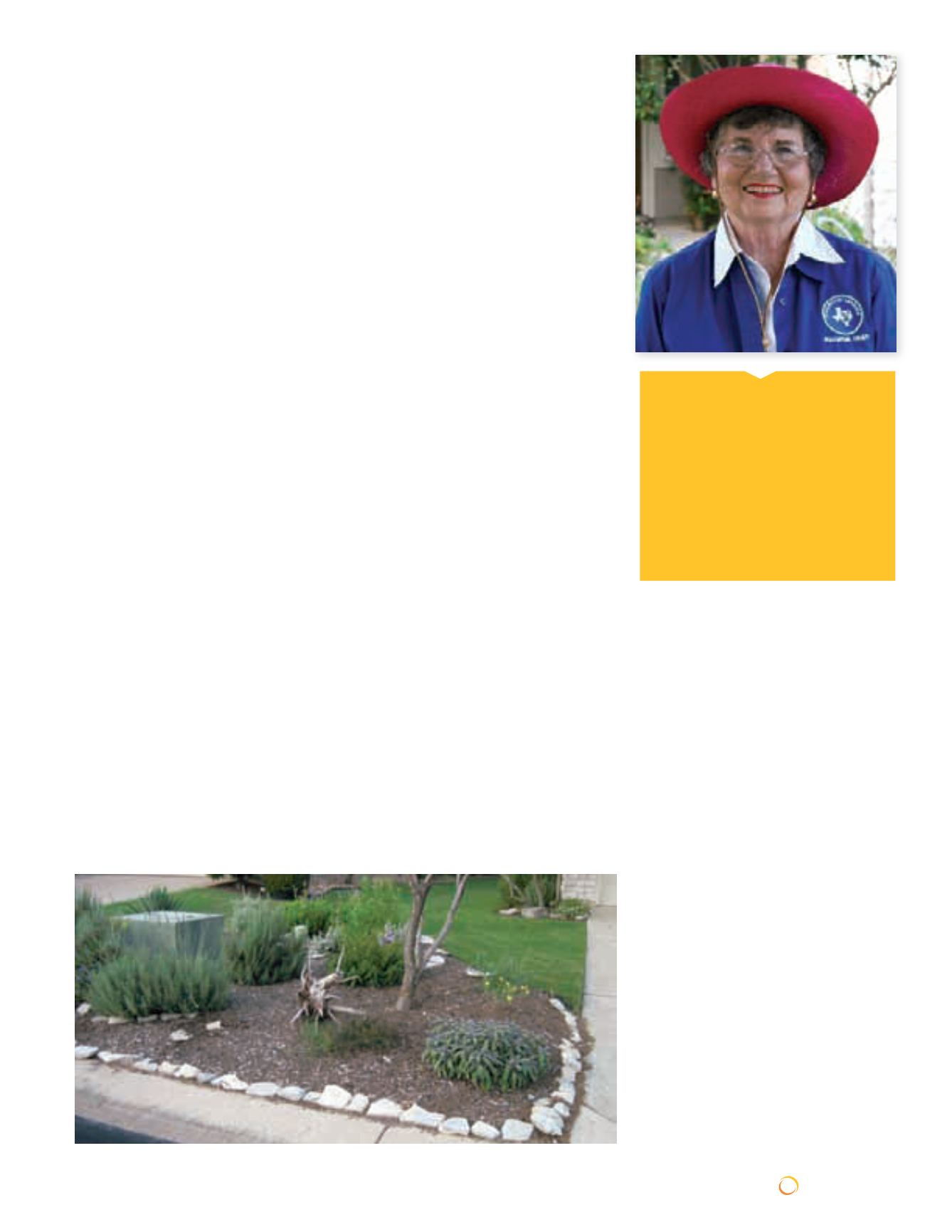
DECEMBER 2013
SUNRAYS | 27
ONLINE:
SCTXCA.ORG
Throughout the year, we have considered
ways to beWaterWise in your landscape―
amending the soil to better retain
moisture, using native/adapted plants,
maintaining sprinkler systems, and
watering deeply, yet less often to develop
deeper roots, as well as letting turf grow
a little taller in summer. We must also
continually look for ways to improve
landscape design for less water usage.
First, look at each watering zone to be
sure that plants are grouped by water
needs. If there are only one or two types
of plants that need more water than
the others, can you transplant them
to another area with similar needs?
If so, this is a good time of year to do
just that. Another possibility is to run
a soaker hose to those few plants that
need supplemental water. For example, I
have three loropetalum bushes that I am
not willing to move, but the other plants
in that zone—crepe myrtle, yaupons,
wildflowers—need no supplemental
water, so I have a soaker hose circling
just those three bushes.
Other thoughts to consider: Could one
of your watering zones be converted to
drip irrigation to reduce evaporation and
prevent run-off? Or, could some water
heads be moved so there is less water
loss to runoff? These conversions could
be simple ways to save water.
A major savings of water can be gained
December Tips for a Beautiful
Water Wise Landscape
NEXT MONTH
:
Join me for ideas
to personalize and add interest to
your 2014 Water Wise landscape!
Winola is a Williamson County
Master Gardener, a member of
the Sun City Garden Club and a
member of the Sun City Water Wise
Task Force.
By Winola VanArtsdalen
by limiting turf. Realistically, once you
have no children living at home and
playing in the yard, howmuch enjoyment
are you really realizing from all that
turf? Could you create some interesting
little sitting areas, special areas for herbs
or other favorite plants, or wildlife areas?
Consider starting with one area and
converting it to a groundcover that
can be watered with drip irrigation―a
much more efficient use of water than
your sprinkler system―or use mulch or
decomposed granite. You may want to
have the fun of converting an area of turf
into a drought-resistant flowerbed. You
will have to water even native plants the
first year or two, but then most of these
plants can be watered once a month or
need no supplemental water at all.
My neighbor and I just converted a good
chunk of turf between our houses into a
drought-resistant flowerbed, as shown in
the photo below. We watered this summer
while plants were getting established,
but are cutting back now. In a couple of
years, these plants—rosemary, silver
leaf germander, cenizo, lavender, blue
mistflower, yucca, etc.―will need no
supplemental water and we can simply
enjoy the wildlife!
(Please check the Design Guidelines or
call the Community Standards Office at
512-948-7462 to see if an application is
required for your landscape modification.)
DECEMBER gARDEnIng TIPS:
• Only water as needed, and check your
irrigation systemmonthly. Be sure to
keep mulch on plants for protection
against temperature extremes. As
organic mulch breaks down, it also
adds nutrients―a double reward for
your efforts!
• This is the best time to transplant
bushes and shrubs, so roots can settle
in before spring growth.
• Be sure to mulch well.
• This is the safest time to trim oaks,
while the nitidulid beetle, which
carries a fungus, is less active, but
still do paint the tree wounds!
• Check your gardening stores and
catalogs to give Santa some helpful
hints for Christmas shopping, and be
sure to use the beautiful foliage from
magnolia, yaupon, artemisia and
others in your holiday decorations.
Source: Texas Agrilife Extension Service
Horticulture Questions:
Contact Williamson County
AgriLIFE Extension Office at
512-943-3300.
DROUGHT-RESISTANT FLOWER BED BY JIM VANARTSDALEN


